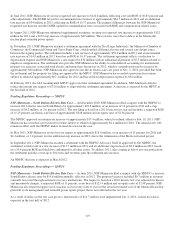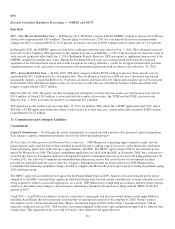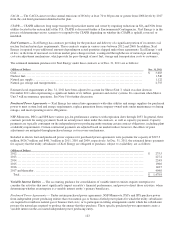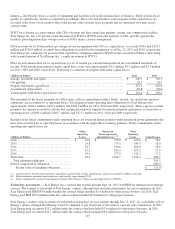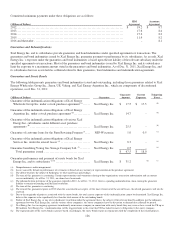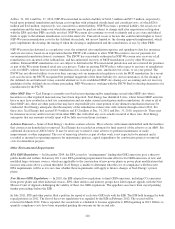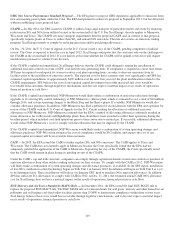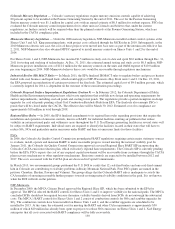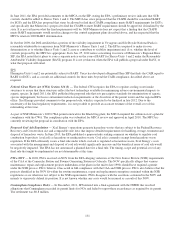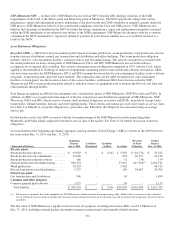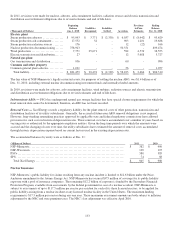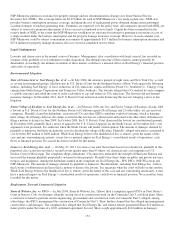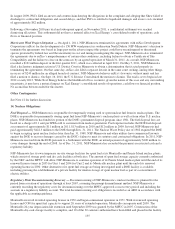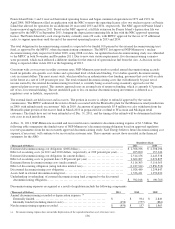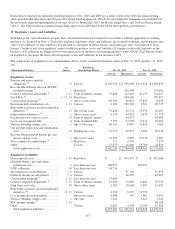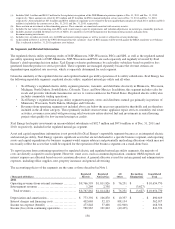Xcel Energy 2011 Annual Report Download - page 138
Download and view the complete annual report
Please find page 138 of the 2011 Xcel Energy annual report below. You can navigate through the pages in the report by either clicking on the pages listed below, or by using the keyword search tool below to find specific information within the annual report.128
At Dec. 31, 2011 and Dec. 31, 2010, NSP-Wisconsin had recorded a liability of $104.3 million and $97.5 million, respectively,
based upon potential remediation and design costs together with estimated outside legal and consultant costs; of which $26.6
million and $4.8 million, respectively, was considered a current liability. NSP-Wisconsin’s potential liability, the actual cost of
remediation and the time frame over which the amounts may be paid are subject to change until after negotiations or litigation
with the EPA and other PRPs are fully resolved. NSP-Wisconsin also continues to work to identify and access state and federal
funds to apply to the ultimate remediation cost of the entire site. Unresolved issues or factors that could result in higher or lower
NSP-Wisconsin remediation costs for the Ashland site include, but are not limited to, the cleanup approach implemented, which
party implements the cleanup, the timing of when the cleanup is implemented and the contributions, if any, by other PRPs.
NSP-Wisconsin has deferred, as a regulatory asset, the estimated site remediation expenses and spending to date less insurance
and rate recoveries, based on an expectation that the PSCW will continue to allow NSP-Wisconsin to recover payments for
environmental remediation from its customers. The PSCW has consistently authorized in NSP-Wisconsin rates recovery of all
remediation costs incurred at the Ashland site, and has authorized recovery of MGP remediation costs by other Wisconsin
utilities. External MGP remediation costs are subject to deferral in the Wisconsin retail jurisdiction and are reviewed for prudence
as part of the Wisconsin biennial retail rate case process. Under an existing PSCW policy with respect to recovery of remediation
costs for MGPs, utilities have recovered remediation costs in natural gas rates, amortized over a four- to six-year period. The
PSCW has not allowed utilities to recover their carrying costs on unamortized regulatory assets for MGP remediation. In a recent
rate case decision, the PSCW recognized the potential magnitude of the future liability for, and circumstances of, the cleanup at
the Ashland site and indicated it may consider alternatives to its established MGP site cleanup cost accounting and cost recovery
guidelines for the Ashland site in a future proceeding. NSP-Wisconsin is working with the PSCW Staff to develop alternatives for
consideration by the PSCW.
Other MGP Sites — Xcel Energy is currently involved in investigating and/or remediating several other MGP sites where
hazardous or other regulated materials may have been deposited. Xcel Energy has identified 8 sites, where former MGP activities
have or may have resulted in actual site contamination and are under current investigation and/or remediation. At some or all of
these MGP sites, there are other parties that may have responsibility for some portion of any ultimate remediation that may be
conducted. Xcel Energy anticipates that the majority of the remediation at these sites will continue through at least 2014. For
these sites, Xcel Energy had accrued $3.9 million and $3.2 million at Dec. 31, 2011 and Dec. 31, 2010, respectively. There may
be insurance recovery and/or recovery from other PRPs that will offset any costs actually incurred at these sites. Xcel Energy
anticipates that any amounts actually spent will be fully recovered from customers.
Asbestos Removal — Some of Xcel Energy’s facilities contain asbestos. Most asbestos will remain undisturbed until the facilities
that contain it are demolished or removed. Xcel Energy has recorded an estimate for final removal of the asbestos as an ARO. See
additional discussion of AROs below. It may be necessary to remove some asbestos to perform maintenance or make
improvements to other equipment. The cost of removing asbestos as part of other work is not expected to be material and is
recorded as incurred as operating expenses for maintenance projects, capital expenditures for construction projects or removal
costs for demolition projects.
Other Environmental Requirements
EPA GHG Regulation — In December 2009, the EPA issued its “endangerment” finding that GHG emissions pose a threat to
public health and welfare. In January 2011, new EPA permitting requirements became effective for GHG emissions of new and
modified large stationary sources, which are applicable to the construction of new power plants or power plant modifications that
increase emissions above a certain threshold. Xcel Energy is unable to determine what the cost of compliance with these new
EPA requirements will be as it is not clear whether these requirements will apply to futures changes at Xcel Energy’s power
plants.
New Mexico GHG Regulations — In 2010, the EIB adopted two regulations to limit GHG emissions, including CO2 emissions
from power plants and other industrial sources. SPS, other utilities and industry groups have filed separate appeals with the New
Mexico Court of Appeals challenging the validity of these two GHG regulations. The appellate cases have been stayed pending
further proceedings before the EIB.
In July 2011, SPS and other parties filed a petition for repeal of each state GHG rule with the EIB. The EIB held hearings for both
repeal petitions in 2011. The first of these two regulations was repealed by the EIB in February 2012. The second will be
reviewed in March 2012. Unless repealed, the second rule is scheduled to become applicable to SPS beginning in 2013. Efforts to
quantify compliance costs have been suspended pending the outcome on the second rule.



